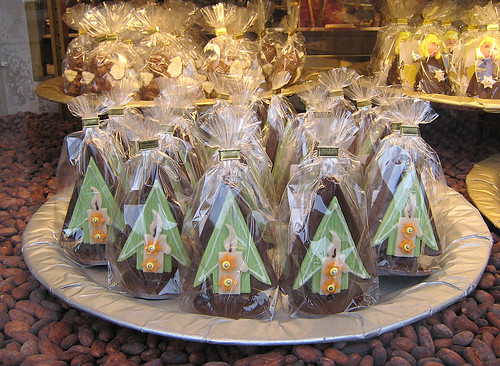
A reader emailed me asking, how people celebrate Christmas in Japan.
My answer to that is ... "Not very well." But I get to pick and choose.
Filed under:
japanese swiss christmas
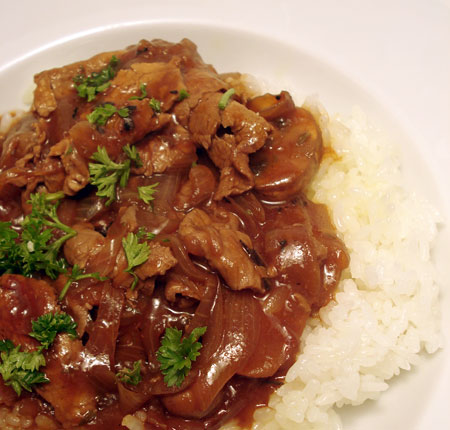
Hayashi raisu or hayashi rice is a Japanese version of a rich beef stew. It's a classic _yohshoku_ (Japanese-adapted Western food) dish.
Filed under:
japanese winter yohshoku beef slowcook meat
I'm still not officially back :) but a reader from Canada had a question in the comments here, which I cannot answer. So, I ask any Canadian residents out there. Do you know of any Canadian sources (or places that will ship food items to Canada) for Japanese food, specifically umeboshi?
I am going to try to compile a worldwide Japanese shopping source list soon, since this type of question does come up all the time.
(For umeboshi specifically, if you can't find it locally at an Asian or Japanese grocery, I'd also try health stores since umeboshi is a highly revered food amongst the macrobiotic set.)
OK, let me shuffle back to the inert/letting the antibiotics do their job state now....
Filed under:
japanese shopping canada
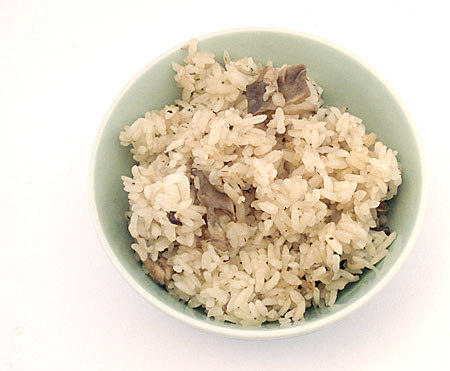
The very first full recipe I posted on Just Hungry almost 4 years ago was Mushroom Rice (kinoko no takikomi gohan), and it still gets a lot of visits and comments, even though there's no photo to whet the reader's appetite or anything.
The original recipe called for traditional dashi stock made from bonito (fish) flakes, and suggested adding chicken and other things.
This version is a lot simpler to assemble and it's all vegan, but it's just as tasty. And it comes with a photo! (My early photos on the site are pretty awful. I like to think I've learned a little since then.) I am using this in an upcoming bento, but it's good for regular dinner too, so it's posted here. It's actually the best when it's freshly made - the aroma of the mushrooms fills the kitchen, quite irresistible if you love mushrooms as I do. It is a very autumn (fall) kind of dish.
I think that this dish reflects my changing tastes and eating habits too, not to mention how I approach writing for Just Hungry, too. 4 years ago, I wasn't that worried about health issues or anything of that nature in regards to food. Now, I am rather proud that I have a tasty dish that is sugar-free, gluten-free (if you use a gluten-free soy sauce), and vegan! I feel a bit trendy.
Filed under:
japanese rice mushrooms fall vegan gluten-free sugar-free
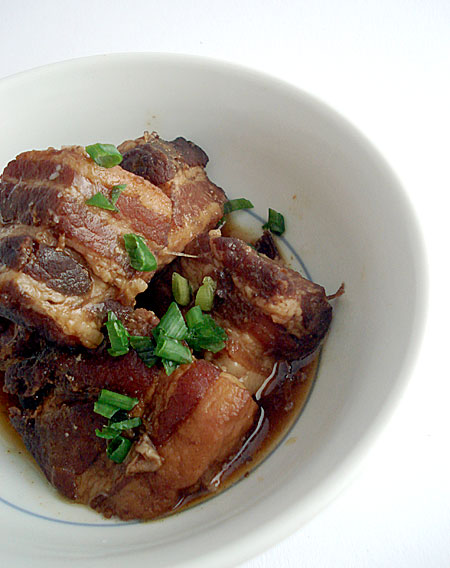
Today is my mother's birthday. In her honor, here is one of the few meat dishes that she still allows in her diet: braised pork belly, or buta no kakuni. It's amazing that she will still eat this, because basically pork belly is bacon without the smoke or salt cure. And in buta no kakuni the bacon, I mean belly, comes in big chunks of layers of meat and unctuous pork fat.
Pork belly recipes exist in other cuisines, especially around northern Europe, but I can't really stand most of them, even if people in Germany and Britain rave about roasted pork belly with crackling. (The crackling part is ok, but the meat part...I don't know.) I like fat in moderation as much as anyone, but that amount of gelatinous pork fat is rather hard to bear. That is unless it's been slowly braised in a salty-sweet liquid for hours and hours, until both the fat and the meat melt in your mouth.
Very similar recipes exist in Chinese (from Peking-style especially) cuisine, and a great Okinawa speciality is _rafute_. This is a bit like rafute but has a bit more spice and things in it, so it's closer to the Peking style I think. Either way it's a great treat once in a great while. It's definitely a cold weather dish.
Filed under:
japanese winter slowcook pork meat
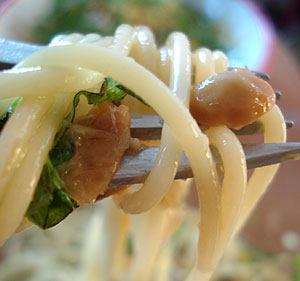
The word wafuu may sound like someone trying to say yahoo and not quite succeeding, but it actually means "Japanese-style" in Japanese.
Italian style pasta has been popular in Japan since the post war period. In the beginning it was served with Italian, or at least Western European, style sauces, but some time in the '70s or so people started to experiment with Japanese flavors. Essentially, things that are usually eaten with white rice were mixed into or put on top of spaghetti and other pastas. These are known as wafuu pasuta or wafuu supagetti (say these out loud and you'll know what they are), and became popular on the menus of Japanese cafés (kissaten) and the like.
There is at least one restaurant in the U.S. that I know of that has a couple of wafuu pasuta dishes on their menu - Basta Pasta (warning: icky Flash-only site!), in New York. They don't really go far enough in my opinion though. If you love Japanese flavors you'll probably love wafuu pasuta too.
Most wafuu pasuta recipes are very quick and easy to make, so they are great for quick dinners. Incidentally, to achieve a more Japanese texture cook the pasta about a minute or so longer than you might otherwise, so it's a bit past al dente. Japanese people generally prefer softer pasta.
Following are three of my favorite quick and easy wafuu pasuta dishes.
Filed under:
japanese natto quickcook yohshoku pasta
Great news for fans of things Japanese who live in Europe, the UK in particular: Daiso, the 100 yen store chain, is opening a branch in London on November 17th. They are teaming up with Japan Centre, one of my favorite sources for Japanese food and other things. (Disclaimer: Japan Centre advertises on this site, but I'm also a happy customer.) It will be at 213 Piccadilly.
If you're not familiar with the awesomeness of 100 yen shops, you owe yourself a visit if you go to London. I am hoping that they will carry plenty of cute goods for the fans of cute. I think I need to go to London soon! I'm rather curious as to how they'll price things at the London store...will everything be a pound? We'll see.
Daiso also has several stores in North America.
An excerpt from the press release follows after the jump.
Filed under:
japanese shopping uk
The French-language blog sooshi has pictures of Uchitomi, a Japanese grocery with stores in Genève and Lausanne. The selection looks very nice!
I have also spotted real yuzu recently at the Bürkliplatz market in Zürich. In the summer I have seen live shiso plants there, both red and green too, Japanese-style sweet potatoes at Barkat, and satoimo (taro roots) at the Indian grocery store next the Hooter's at Helvetiaplatz. It's really great to see more 'exotic' Japanese and Asian produce more easily available here. When I first came to visit Switzerland back in the mid-'90s, you had to buy fresh ginger in the exotic food department at Globus! How times have changed. .
Filed under:
japanese shopping switzerland
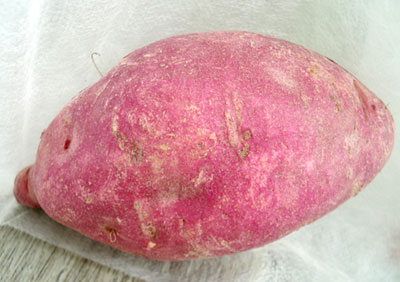
My general 'simple is better' attitude to food has continued into the fall. At the moment I'm not cooking much per se, but I am enjoying the foods that are so good at this time of the year. A lot of these foods share a similar quality, for which I can't think of an appropriate word in English to describe. There's a perfect word in Japanese though - hoku hoku. Hoku hoku is the word that is used for a starchy, dense, sweet flavor and texture. Think of roasted sweet chestnuts, winter squash, and sweet potatoes. Baked white potatoes can be hoku hoku too.
My favorite hoku hoku food is sweet potato - though I do mean the kind we get in Japan (called satsuma-imo), not the kind that's most commonly seen in the U.S. (and here in Europe too). The U.S. kind of sweet potato has an orange skin and bright orange-yellow flesh, but the Japanese kind that I grew up with has a pale cream-white flesh and pink-purple skin. It's less fibrous and sweeter than the orange-flesh kind, which I feel needs added sweeteners most of the time (which is why it's so great in sweet potato pie and the like).
Filed under:
japanese fall
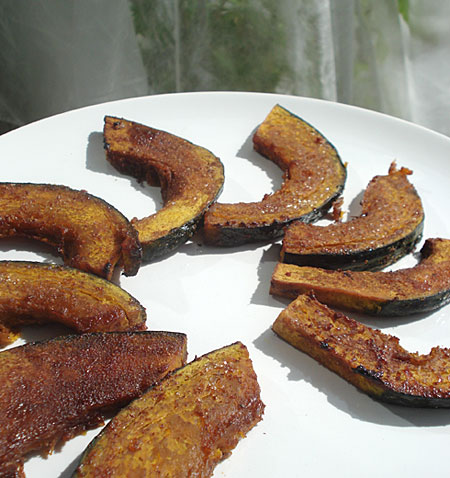
I hesitated to put this recipe up, because it's not the prettiest thing in the world. But it's so tasty, dead easy to make, and of this season - so, here it is. As a bonus it's full of fibre and is relatively low-calorie, low-sugar etc for people who want a bit of something sweet without going on a massive guilt trip.
Most recipes out there for using winter squash seem to involve pureeing them, but I rather like them when they are in chunks or slices. This roasted squash has a sweet, spicy and salty glaze of sorts on them, which brings out the dense sweetness of the fruit. Cut into fairly thin slices like this, it makes interesting finger food. You can vary the sugar and spice to your taste, though too much of either may overwhelm it.
You do need to use kabocha-type squash for this ideally, though butternut should work too. You will need a dense, starchy and sweet squash. Don't use regular pumpkin, which is too watery and lacks sweetness. (Rouge d'etampes pumpkin may work, but I've found their sweetness to vary quite a bit.)
Filed under:
japanese fall vegetarian sweet vegan
Pages